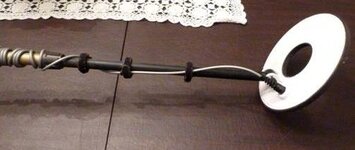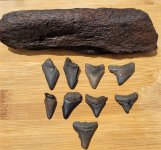You are using an out of date browser. It may not display this or other websites correctly.
You should upgrade or use an alternative browser.
You should upgrade or use an alternative browser.
Routing coil cable
- Thread starter digthis
- Start date
- May 28, 2010
- 19,424
- 30,111
- 🥇 Banner finds
- 1
- 🏆 Honorable Mentions:
- 1
- Detector(s) used
- Nokta Makro Legend// Pulsedive// Minelab GPZ 7000// Vanquish 540// Minelab Pro Find 35// Dune Kraken Sandscoop// Grave Digger Tools Tombstone shovel & Sidekick digger// Bunk's Hermit Pick
- Primary Interest:
- Metal Detecting
Sandman
Gold Member
- Aug 6, 2005
- 13,398
- 3,992
- Detector(s) used
- Excal 1000, Excal II, Sovereign GT, CZ-20, Tiger Shark, Tejon, GTI 1500, Surfmaster Pulse, CZ6a, DFX, AT PRO, Fisher 1235, Surf PI Pro, 1280-X, many more because I enjoy learning them. New Garrett Ca
- Primary Interest:
- All Treasure Hunting
If your going to hip mount the detector you should run the cable straight up one side to the handle and tape it every couple inches. This cuts water resistance which can tire your out faster.
digthis
Jr. Member
- May 22, 2012
- 21
- 4
- Primary Interest:
- All Treasure Hunting
- Thread starter
- #4
Thanks Terry that's what I needed to know, From what I read the cable straight from the coil to roughly a foot to the first wrap helps with sensitivity, Is that correct? Sandman Thanks for the tip! I haven't got that far yet to try any type of water areas, But couldn't you drill a hole in the rod about were 1st wrap is at and route it inside and drill another for cable coming out then you'll have less resistance in water or air for that matter? If you wanted to take time to do something like that....steve {p.s.}I wonder why treasurenet doesn't have a dirt or water fisher swingin his metal detector real slow or fast avatar? Mind you just for poops and giggles!
- May 28, 2010
- 19,424
- 30,111
- 🥇 Banner finds
- 1
- 🏆 Honorable Mentions:
- 1
- Detector(s) used
- Nokta Makro Legend// Pulsedive// Minelab GPZ 7000// Vanquish 540// Minelab Pro Find 35// Dune Kraken Sandscoop// Grave Digger Tools Tombstone shovel & Sidekick digger// Bunk's Hermit Pick
- Primary Interest:
- Metal Detecting
Yes, in my experience the higher wrap does help sensitivity, and also cuts down EMI proplems.
digthis
Jr. Member
- May 22, 2012
- 21
- 4
- Primary Interest:
- All Treasure Hunting
- Thread starter
- #6
So different situations call for different wrapping techniques basically? I plan on searching in fields, woods, uneven landscape and such! So by having the coil cable wrapped as per above photo could it cause more possible snags such as in plowed fields with limbs above soil, wooded areas with snaggy weeds, limbs etc... v.s wrapping the cable closely to the rod for less open areas in the wrap to get snagged on since you want to stay as close to ground level while sweeping the metal detector, is the increased sensitivity you receive worth it to wrap as above? Just a newbie asking questions! Thanks for all info! steve 

olfacere
Full Member
- Feb 22, 2013
- 154
- 61
- Detector(s) used
-
Tesoro MicroMax Silver
Garrett Pro Pinpointer
- Primary Interest:
- Metal Detecting
To be clear, you can't add sensitivity to your machine by using a special cable wrap. You can, however, prevent the loss of sensitivity from wrapping it incorrectly (improves sensitivity by cutting EMI). The big things to avoid in wrapping your cable are leaving too much wrapped low (near the coil) and leaving the cable near the coil too slack. Having a bulk of cabling wrapped near the coil changes the field shape. Having a loose, wiggly cable near the coil may cause the machine to respond to the cable. You can actually hear this if you want. Just leave the cable really slack around the coil end and swing the machine rapidly back and forth. If the cable is causing a problem, you will hear "click-beep" artifacts that shouldn't be there.
There are a few considerations that each detectorist will have to establish for themselves, based on their goals. While I keep my cable really close against the shaft to prevent snags, I hadn't even considered the water resistance angle. Because I intend to stay on dry land (and don't have a waterproofed detector anyway), water resistance never occurred to me.
So, you should take those considerations from your goals and combine them with general good practice from other areas. I've had some experience over the years routing communication cables and there was a time when I studied rope-making. So, when I got my first detector, I knew that I wanted the cable to lay closely to the shaft under its own smooth, gentle tension (keeping its shape by itself, like a rope) to avoid snags and kinks in the cable; I wanted to limit free movement of the cable as much as possible; and I wanted to do those two things without any straps, ties, nor tapes. Here's how.
Basically, there is no proper way to wrap a 7 foot cord around a 2 foot pole, so start with the shorter coil cable whenever possible (you can still avoid the pitfalls, but it's just too much cable). Attach the coil to the end of the shaft with the cable hanging loosely (and straight, no kinks nor twists). Now take the shaft in one hand (near the coil) and the cable in the other. Make sure not to apply any pressure to the cable, just let it spin in your hand as you guide it up the shaft. Now, slowly spin the shaft and let the cable lay down on the shaft with no tension. If you lay it down correctly, then it will sit like that by itself. Then make some kind of finishing loop at the top and connect the cable to the control box.
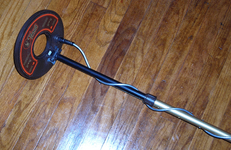
Note in the above picture, the cable is not pulled sharply to the side when it leaves the coil to loop around the shaft. It hangs straight by its own stiffness and position against the shaft. This is the same position, though sitting a little differently because of cable length, as Terry showed in his picture.
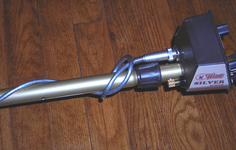
This is the "finishing loop" I mentioned. When I first installed the coil, I left the loop just hanging there at the top and its natural tension kept it there pretty well, but it didn't sit quite snug enough against itself and the shaft. So, I ran the end of the cable through the loop and basically made a knot that never gets tightened. (Note that the cable isn't pulled sharply to the side here either.) If you leave the cable in this configuration, it will provide tension against itself and the shaft to hold itself in place without any straps, ties, nor tapes. When you get done, it should look something like this and not need regular adjustment.
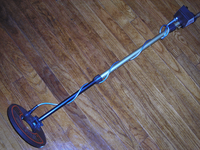
There are a few considerations that each detectorist will have to establish for themselves, based on their goals. While I keep my cable really close against the shaft to prevent snags, I hadn't even considered the water resistance angle. Because I intend to stay on dry land (and don't have a waterproofed detector anyway), water resistance never occurred to me.
So, you should take those considerations from your goals and combine them with general good practice from other areas. I've had some experience over the years routing communication cables and there was a time when I studied rope-making. So, when I got my first detector, I knew that I wanted the cable to lay closely to the shaft under its own smooth, gentle tension (keeping its shape by itself, like a rope) to avoid snags and kinks in the cable; I wanted to limit free movement of the cable as much as possible; and I wanted to do those two things without any straps, ties, nor tapes. Here's how.
Basically, there is no proper way to wrap a 7 foot cord around a 2 foot pole, so start with the shorter coil cable whenever possible (you can still avoid the pitfalls, but it's just too much cable). Attach the coil to the end of the shaft with the cable hanging loosely (and straight, no kinks nor twists). Now take the shaft in one hand (near the coil) and the cable in the other. Make sure not to apply any pressure to the cable, just let it spin in your hand as you guide it up the shaft. Now, slowly spin the shaft and let the cable lay down on the shaft with no tension. If you lay it down correctly, then it will sit like that by itself. Then make some kind of finishing loop at the top and connect the cable to the control box.

Note in the above picture, the cable is not pulled sharply to the side when it leaves the coil to loop around the shaft. It hangs straight by its own stiffness and position against the shaft. This is the same position, though sitting a little differently because of cable length, as Terry showed in his picture.

This is the "finishing loop" I mentioned. When I first installed the coil, I left the loop just hanging there at the top and its natural tension kept it there pretty well, but it didn't sit quite snug enough against itself and the shaft. So, I ran the end of the cable through the loop and basically made a knot that never gets tightened. (Note that the cable isn't pulled sharply to the side here either.) If you leave the cable in this configuration, it will provide tension against itself and the shaft to hold itself in place without any straps, ties, nor tapes. When you get done, it should look something like this and not need regular adjustment.

Last edited:
digthis
Jr. Member
- May 22, 2012
- 21
- 4
- Primary Interest:
- All Treasure Hunting
- Thread starter
- #8
Seems the solution would be for manufacturers to have the cable coming out of the coil closest to the rod in which the cable would be right up against the rod and straight to the 1st wrap, and you can secure cable at it's lowest point without creating a gap? olfacere you don't have problems with that gap at the bottom snagging on things? 

olfacere
Full Member
- Feb 22, 2013
- 154
- 61
- Detector(s) used
-
Tesoro MicroMax Silver
Garrett Pro Pinpointer
- Primary Interest:
- Metal Detecting
Center-to-center, the cable is mounted on this coil 2 inches from the shaft. It's not too much of a gap in most field conditions. My cable tends to lay against the shaft about six inches above the coil. The cable is also mounted more than an inch from the outside of the coil (including scuff cover; highly recommended), so it doesn't protrude. I wouldn't want to wrap tighter than that because it would put a constant sheering force on the cable at its mount point. I find this configuration to be a neat, reliable compromise between a lot of options. It's only necessary to wrap the cable tighter or closer if you plan on being somewhat abusive to it. With a little care, no further protection should be needed.
Users who are viewing this thread
Total: 2 (members: 0, guests: 2)



